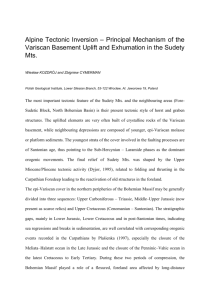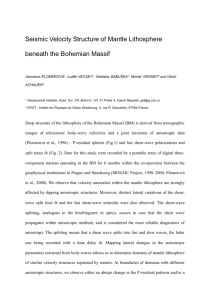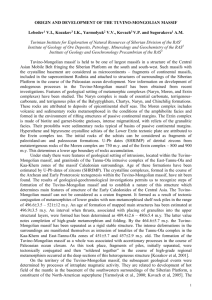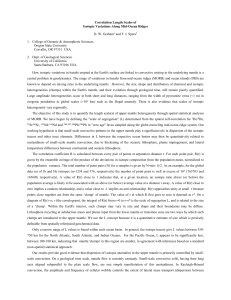References
advertisement
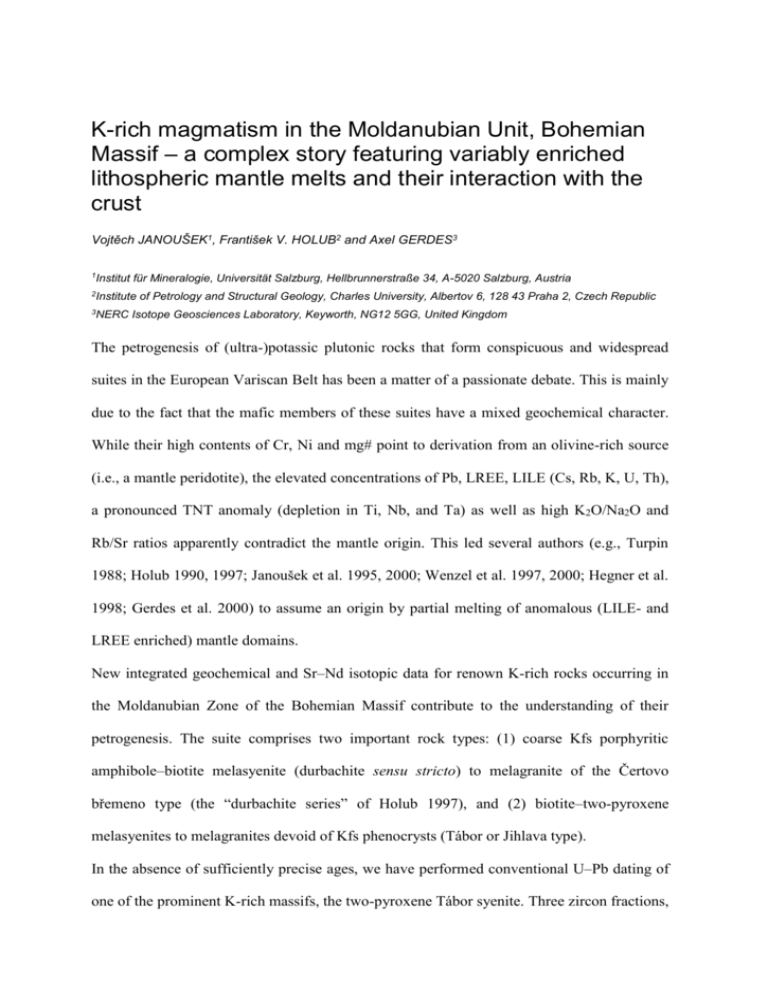
K-rich magmatism in the Moldanubian Unit, Bohemian Massif – a complex story featuring variably enriched lithospheric mantle melts and their interaction with the crust Vojtěch JANOUŠEK1, František V. HOLUB2 and Axel GERDES3 1Institut für Mineralogie, Universität Salzburg, Hellbrunnerstraße 34, A-5020 Salzburg, Austria 2Institute 3 of Petrology and Structural Geology, Charles University, Albertov 6, 128 43 Praha 2, Czech Republic NERC Isotope Geosciences Laboratory, Keyworth, NG12 5GG, United Kingdom The petrogenesis of (ultra-)potassic plutonic rocks that form conspicuous and widespread suites in the European Variscan Belt has been a matter of a passionate debate. This is mainly due to the fact that the mafic members of these suites have a mixed geochemical character. While their high contents of Cr, Ni and mg# point to derivation from an olivine-rich source (i.e., a mantle peridotite), the elevated concentrations of Pb, LREE, LILE (Cs, Rb, K, U, Th), a pronounced TNT anomaly (depletion in Ti, Nb, and Ta) as well as high K2O/Na2O and Rb/Sr ratios apparently contradict the mantle origin. This led several authors (e.g., Turpin 1988; Holub 1990, 1997; Janoušek et al. 1995, 2000; Wenzel et al. 1997, 2000; Hegner et al. 1998; Gerdes et al. 2000) to assume an origin by partial melting of anomalous (LILE- and LREE enriched) mantle domains. New integrated geochemical and Sr–Nd isotopic data for renown K-rich rocks occurring in the Moldanubian Zone of the Bohemian Massif contribute to the understanding of their petrogenesis. The suite comprises two important rock types: (1) coarse Kfs porphyritic amphibole–biotite melasyenite (durbachite sensu stricto) to melagranite of the Čertovo břemeno type (the “durbachite series” of Holub 1997), and (2) biotite–two-pyroxene melasyenites to melagranites devoid of Kfs phenocrysts (Tábor or Jihlava type). In the absence of sufficiently precise ages, we have performed conventional U–Pb dating of one of the prominent K-rich massifs, the two-pyroxene Tábor syenite. Three zircon fractions, each consisting of 1–3 abraded grains, yield a concordia age of 336.6 ± 1.0 Ma (Janoušek and Gerdes, in print). The Pb–Pb age (336.3 ± 0.8 Ma) of a multigrain rutile fraction is identical within error, which argues strongly for a rapid cooling below c. 600 °C (closure temperature of the U–Pb system in rutile: Cherniak, 2000). Accordingly, the Sr–Nd isotopic data, acquired in the laboratories of the Czech Geological Survey and the Activation Laboratories, Ancaster (Holub and Janoušek, in print), were agecorrected to 337 Ma. All show highly radiogenic Sr (87Sr/86Sri = 0.71026–0.71272) coupled with unradiogenic Nd (iNd = -6.1 to -7.6). As shown previously, this cannot be ascribed to crustal assimilation as the high contents of radiogenic Sr and unradiogenic Nd render these rocks impervious to contamination by common Moldanubian lithologies. Moreover, primitive whole-rock geochemistry of the mafic rock types (high Cr, Ni and mg#) requires their derivation from a mantle source (Holub 1990, 1997; Janoušek et al. 1995). The Sr/86Sri–iNd plot shows a linear trend spanning two extreme compositions: (1) mafic 87 ultrapotassic, corresponding to minettes (Janoušek et al., 1995), most mafic variety of the biotite-poor two-pyroxene melasyenite from Tábor and durbachites from the Mehelník and Netolice massifs (87Sr/86Sri = 0.7119–0.7128; iNd = -7.4 to -7.5), and (2) more felsic, equivalent to the light facies (melagranite) of the Čertovo břemeno type from the Central Bohemian plutonic complex and the Třebíč pluton (87Sr/86Sri < 0.7105; iNd -6.3 to -6.5). Analogous correlations observed between other geochemical parameters (e.g., SiO2, Cr, MgO, mg#) and initial Sr–Nd isotopic ratios, support the origin of the whole spectrum of the studied K-rich plutonic rocks as well as the associated minettes by mixing of two distinct magma types proposed by Holub (1990, 1997) and Gerdes et al. (2000): ultrapotassic, originated by partial melting of enriched mantle domains, and acid, crustal-derived. Even though the isotopic composition of the mafic end-member is constrained well at Sr/86Sri > 0.712 and iNd ~ -7.5, the nature of the acid end-member is more problematic as 87 its proportions in the felsic durbachitic rocks can be only estimated. The limits are provided by the most silicic (66 % SiO2), least magnesian and, at the same time, isotopically most primitive durbachitic melagranite from the Třebíč pluton (87Sr/86Sri < 0.7103 and iNd < -6.3). Moreover, the fact that the trend fitted to the 87 Sr/86Sri – iNd data is linear (i.e., hyperbola with curvature equalling unity) shows that the elemental Sr/Nd ratios of both end-members must have been similar to each other (~ 6.5–8). Better approximation can be still obtained from plots of MgO or Cr, whose concentrations in the acid end-member were estimated by Holub (1997) at 0.2–0.5 % and < 20 ppm, respectively. As indicated by linear extrapolation, the 87Sr/86Sri ratio must have been slightly lower than 0.7095 and iNd ~ -5.5. This, together with the whole-rock geochemical intervals outlined by Holub (1997), imposes severe constraints on the acid member composition. In the Central Bohemian plutonic complex, for instance, some aplite dykes associated with the Blatná intrusion display an appropriate isotopic composition (see van Breemen et al., 1982; Košler, 1993; 87Sr/86Sr337 = 0.7085 and 337Nd = -5.8). We cannot exclude a possible role of leucogranitic and aplitic rocks spatially associated with durbachites as numerous dykes, whose isotopic compositions are still unknown. The U–Pb age for the Tábor intrusion indicates a narrow time gap between the high-grade metamorphism (c. 340 Ma: Kröner et al., 2000), the emplacement of the granulite-bearing Gföhl nappe and intrusion of K-rich magmas cutting it. The obtained age is comparable with the data from analogous rock types penetrating the Variscan high-grade nappe units (Massif Central, Vosges, Schwarzwald, Bohemian Massif, Alps and Corsica – see the reviews in Wenzel et al., 1997; Schaltegger, 1997) and suggests a nearly synchronous melting of the variously enriched subcontinental mantle along the Variscan Belt. References CHERNIAK D.J., 2000. Pb diffsuion in rutile. Contrib. Mineral. Petrol., 139: 198-207. GERDES A., WÖRNER G. and FINGER F., 2000. Hybrids, magma mixing and enriched mantle melts in post-collisional Variscan granitoids: the Rastenberg Pluton, Austria. In: W. FRANKE, V. HAAK, O. ONCKEN and D. TANNER (Editors), Orogenic Processes: Quantification and Modelling in the Variscan Fold Belt. Geological Society London Special Publication 179, London, pp. 415-431. HEGNER E., KÖLBL–EBERT M. and LOESCHKE J., 1998. Post-collisional Variscan lamprophyres (Black Forest, Germany): 40Ar/39Ar phlogopite dating, Nd, Pb, Sr isotope and trace element characteristics. Lithos, 45: 395-411. HOLUB F.V., 1990. Petrogenetická interpretace chemismu kaliových lamproidů evropských Hercynid. PhD. thesis, Charles University, Prague. HOLUB F.V., 1997. Ultrapotassic plutonic rocks of the durbachite series in the Bohemian Massif: Petrology, geochemistry and petrogenetic interpretation. Sbor. geol. Věd, ložisk. Geol. Mineral., 31: 5-26. HOLUB F.V. and JANOUŠEK V., 2003. Geochemical and Sr–Nd isotopic constraints on the genesis of ultrapotassic plutonic rocks from the moldanubian zone of the Bohemian Massif. J. Czech Geol. Soc., in print. JANOUŠEK V., ROGERS G. and BOWES D.R., 1995. Sr–Nd isotopic constraints on the petrogenesis of the Central Bohemian Pluton, Czech Republic. Geol. Rdsch., 84: 520-534. JANOUŠEK V., BOWES D.R., ROGERS G., FARROW C.M. and JELÍNEK E., 2000. Modelling diverse processes in the petrogenesis of a composite batholith: the Central Bohemian Pluton, Central European Hercynides. J. Petrology, 41: 511-543. KOŠLER J., 1993. Age and geochemistry of the Staré Sedlo and Mirotice complexes, Bohemian Massif, Czech Republic. PhD. thesis, Glasgow University, Glasgow. KRÖNER A., O'BRIEN P.J., NEMCHIN A.A. and PIDGEON R.T., 2000. Zircon ages for high pressure granulites from South Bohemia, Czech Republic, and their connection to Carboniferous high temperature processes. Contrib. Mineral. Petrol., 138: 127-142. SCHALTEGGER U., 1997. Magma pulses in the Central Variscan Belt: episodic melt generation and emplacement during lithospheric thinning. Terra Nova, 9: 242-245. TURPIN L., VELDE D. and PINTE G., 1988. Geochemical comparison between minettes and kersantites from the Western European Hercynian orogen: trace element and Pb–Sr–Nd isotope constraints on their origin. Earth Planet. Sci. Lett., 87: 73-86. VAN BREEMEN O., AFTALION M., BOWES D.R., DUDEK A., MÍSAŘ Z., POVONDRA P. and VRÁNA S., 1982. Geochronological studies of the Bohemian Massif, Czechoslovakia, and their significance in the evolution of Central Europe. Trans. Roy. Soc. Edinb, Earth Sci., 73: 89-108. WENZEL T., MERTZ D.F., OBERHÄNSLI R., BECKER T. and RENNE P.R., 1997. Age, geodynamic setting, and mantle enrichment processes of a K-rich intrusion from the Meissen massif (northern Bohemian Massif) and implications for related occurrences from the midEuropean Hercynian. Geol. Rundsch., 86: 556-570. WENZEL T., OBERHÄNSLI R. and MEZGER K., 2000. K-rich plutonic rocks and lamprophyres from the Meissen Massif (northern Bohemian Massif): Geochemical evidence for variably enriched lithospheric mantle sources. Neu. Jb. Mineral., Abh., 175: 249-293.
